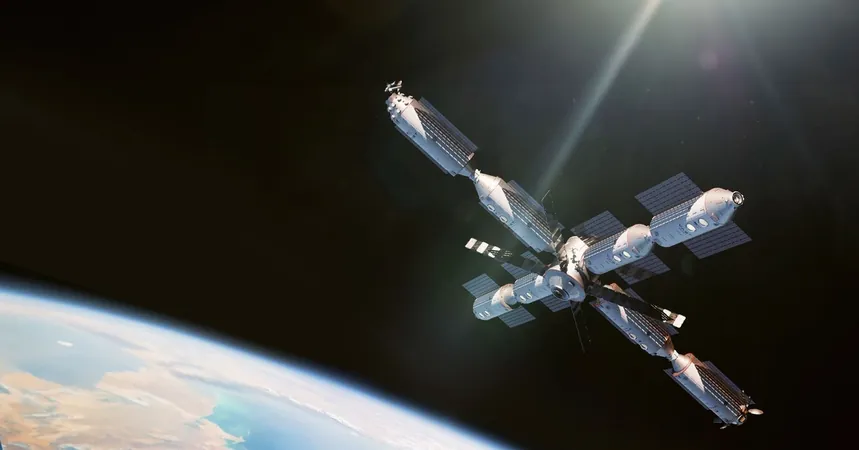
Vast Space: Pioneering a Revolutionary Artificial Gravity Space Station by 2028!
2025-01-22
Author: Lok
Overview
In an audacious move that could redefine the future of space travel, California-based company Vast Space is on a mission to launch a groundbreaking commercial space station named Haven-2 into low Earth orbit by 2028.
This ambitious project is set to fill the void left by the imminent decommissioning of the International Space Station (ISS) in 2030, allowing astronauts to continue their work in the cosmos.
But what sets Vast Space apart? It's their daring goal of creating a station equipped with artificial gravity!
Vision for Artificial Gravity
Max Haot, the CEO of Vast, highlights the importance of artificial gravity in long-term space habitation: "We know that in weightlessness we can live a year or so, and in conditions that are not easy. However, lunar or Martian gravity may be enough for comfortable long-term living. The only way to find out is to construct stations with artificial gravity, and that’s our ultimate objective."
Company Background and Collaborations
Founded in 2021 by tech entrepreneur Jed McCaleb—famed for his role in creating eDonkey and the now-defunct Mt. Gox—Vast Space is ramping up its efforts in collaboration with SpaceX.
They recently announced two upcoming missions to the ISS, which will serve as crucial stepping stones toward launching Haven-1, their first space station, planned for 2025.
These missions will fit into NASA’s private astronaut missions program, which aims to foster a vibrant space economy in low Earth orbit.
Features of Haven-1 and Haven-2
Haven-1 will feature a habitable volume of 45 cubic meters, a docking port, crew quarters, a laboratory, and a communal table with a stunning view through a domed window.
Nestled about 425 kilometers above Earth, it will utilize cutting-edge Starlink laser communications, an exciting technology tested during the Polaris Dawn mission in 2024.
Competitive Landscape
While Vast aims to showcase its capabilities and compete in NASA’s Commercial Destinations in Low Earth Orbit (CLD) program, they are not the only players in the commercial space station arena.
Competitors like Axiom Space are also vying for contracts, but Vast Space is determined to outpace them.
Haot noted, 'We are aware we are lagging behind… but we will demonstrate our capabilities with the launch of Haven-1 in late 2025.'
Future Aspirations with Haven-2
The Haven-2 project, projected for completion in 2030, promises even greater advancements. Featuring enhanced design elements, like two docking ports and twice the pressurized volume of Haven-1, it aims to accommodate up to 12 astronauts.
This comes as NASA looks towards bolstering its next wave of operations in space.
Conclusion
With plans for artificial gravity testing beginning on Haven-1 before project completion, Vast Space’s ambitions reflect a broader goal: to unlock a commercially viable market for space habitats.
Haot shares an optimistic view, saying, 'Previous space stations have been costly government endeavors. Our aim is to reduce costs significantly—up to five times—for prospective customers.'
The stakes are high, and the world will be watching as Vast Space pushes the boundaries of what is possible in human space exploration.
As they embark on this bold journey, the question remains: will they reshape the commercial space landscape and make artificial gravity a reality? Stay tuned!


 Brasil (PT)
Brasil (PT)
 Canada (EN)
Canada (EN)
 Chile (ES)
Chile (ES)
 Česko (CS)
Česko (CS)
 대한민국 (KO)
대한민국 (KO)
 España (ES)
España (ES)
 France (FR)
France (FR)
 Hong Kong (EN)
Hong Kong (EN)
 Italia (IT)
Italia (IT)
 日本 (JA)
日本 (JA)
 Magyarország (HU)
Magyarország (HU)
 Norge (NO)
Norge (NO)
 Polska (PL)
Polska (PL)
 Schweiz (DE)
Schweiz (DE)
 Singapore (EN)
Singapore (EN)
 Sverige (SV)
Sverige (SV)
 Suomi (FI)
Suomi (FI)
 Türkiye (TR)
Türkiye (TR)
 الإمارات العربية المتحدة (AR)
الإمارات العربية المتحدة (AR)